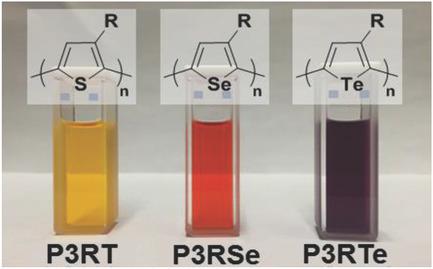当前位置:
X-MOL 学术
›
Adv. Energy Mater.
›
论文详情
Our official English website, www.x-mol.net, welcomes your feedback! (Note: you will need to create a separate account there.)
Effect of Heteroatom and Doping on the Thermoelectric Properties of Poly(3‐alkylchalcogenophenes)
Advanced Energy Materials ( IF 27.8 ) Pub Date : 2018-10-14 , DOI: 10.1002/aenm.201802419 Shawn A. Gregory 1 , Akanksha K. Menon 2 , Shuyang Ye 3 , Dwight S. Seferos 3, 4 , John R. Reynolds 5 , Shannon K. Yee 2
Advanced Energy Materials ( IF 27.8 ) Pub Date : 2018-10-14 , DOI: 10.1002/aenm.201802419 Shawn A. Gregory 1 , Akanksha K. Menon 2 , Shuyang Ye 3 , Dwight S. Seferos 3, 4 , John R. Reynolds 5 , Shannon K. Yee 2
Affiliation

|
This study reports on the thermoelectric properties of poly(3‐alkylchalcogenophene) thin films (500 nm) as a function of heteroatom (sulfur, selenium, tellurium), and how these properties change with dopant (ferric chloride) concentration. UV–vis–NIR spectroscopy shows that polaronic charge carriers are formed upon doping. Poly(3‐alkyltellurophene) (P3RTe) is most easily doped followed by poly(3‐alkylselenophene) (P3RSe) and poly(3‐alkylthiophene) (P3RT), where R = 3,7‐dimethyloctyl chain is the pendant alkyl group. Thermoelectric properties vary as functions of the heteroatom and doping level. At low dopant concentrations (≈1 × 10−3
m), P3RTe shows the highest power factor of 10 µW m−1 K−2, while, at higher dopant concentrations (≈5 × 10−3
m), P3RSe shows the highest power factor of 13 µW m−1 K−2. Most notably, it is found that the measured properties are consistent with Mott's polaron hopping model and not consistent with other transport models. Additionally, temperature‐dependent conductivity measurements show that for a given dopant concentration, the activation energies for electronic transport decrease as the heteroatom is changed from sulfur to selenium to tellurium. Overall, this work presents a systematic study of poly(chalcogenophenes) and indicates the potential of polymers beyond P3HT by tuning the heteroatom and doping level for optimized thermoelectric performance.
中文翻译:

杂原子和掺杂对聚(3-烷基硫属元素金属)热电性能的影响
这项研究报告了聚(3-烷基硫属元素oph)薄膜(500 nm)的热电性质与杂原子(硫,硒,碲)的关系,以及这些性质如何随掺杂剂(氯化铁)浓度的变化而变化。紫外-可见-近红外光谱表明,掺杂后会形成极化电荷载流子。聚(3-烷基二茂铁)(P3RTe)最容易掺杂,其次是聚(3-烷基硒吩)(P3RSe)和聚(3-烷基噻吩)(P3RT),其中R = 3,7-二甲基辛基链是侧链烷基。热电性能随杂原子和掺杂水平的变化而变化。在低掺杂物浓度(≈1×10 -3 m)时,P3RTe的最高功率因数为10 µW m -1 K -2,而在较高掺杂物浓度(≈5×10-3 m),P3RSe的最高功率因数为13 µW m -1 K -2。最值得注意的是,发现测量的特性与Mott的极化子跳跃模型一致,而与其他传输模型不一致。此外,随温度变化的电导率测量结果表明,对于给定的掺杂剂浓度,随着杂原子从硫到硒再到碲的变化,电子传输的活化能降低。总的来说,这项工作提出了对聚硫属元素的系统研究,并通过调整杂原子和掺杂水平来优化热电性能,表明了P3HT以外的聚合物的潜力。
更新日期:2018-10-14
中文翻译:

杂原子和掺杂对聚(3-烷基硫属元素金属)热电性能的影响
这项研究报告了聚(3-烷基硫属元素oph)薄膜(500 nm)的热电性质与杂原子(硫,硒,碲)的关系,以及这些性质如何随掺杂剂(氯化铁)浓度的变化而变化。紫外-可见-近红外光谱表明,掺杂后会形成极化电荷载流子。聚(3-烷基二茂铁)(P3RTe)最容易掺杂,其次是聚(3-烷基硒吩)(P3RSe)和聚(3-烷基噻吩)(P3RT),其中R = 3,7-二甲基辛基链是侧链烷基。热电性能随杂原子和掺杂水平的变化而变化。在低掺杂物浓度(≈1×10 -3 m)时,P3RTe的最高功率因数为10 µW m -1 K -2,而在较高掺杂物浓度(≈5×10-3 m),P3RSe的最高功率因数为13 µW m -1 K -2。最值得注意的是,发现测量的特性与Mott的极化子跳跃模型一致,而与其他传输模型不一致。此外,随温度变化的电导率测量结果表明,对于给定的掺杂剂浓度,随着杂原子从硫到硒再到碲的变化,电子传输的活化能降低。总的来说,这项工作提出了对聚硫属元素的系统研究,并通过调整杂原子和掺杂水平来优化热电性能,表明了P3HT以外的聚合物的潜力。



























 京公网安备 11010802027423号
京公网安备 11010802027423号